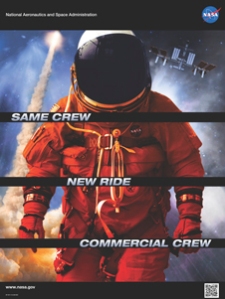NASA Releases Draft Proposal for Final Phase of Commercial Crew
On Friday, July 19th, NASA released a draft Request for Proposal for the next phase of the Commercial Crew competition, and with it came some new acronyms. Following Commercial Crew Integrated Capacity (CCiCap), the fourth and final phase will be called Commercial Crew Transportation Capability (CCtCap) and is intended to ” develop a U.S. commercial crew space transportation capability to achieve safe, reliable and cost-effective access to and from the International Space Station (ISS) with a goal of no later than 2017.”
CCtCap will be divided into two phases; Design, Development, Test and Evaluation (DDTE) to procure the crew systems and conduct test flights, followed by Post Certification Missions (PCM) to conduct the operational flights. The two segments are covered by four Contract Line Items (CLIN).
CLIN 001 and 002 are for the testing and operational phases respectively. CLIN 003 is labelled “Special Studies” and enables NASA to pursue risk reduction activities over and above those required for other the other three categories. The fourth item, CLIN 004 “Cargo in Excess of Requirements” is perhaps the most interesting in that it allows the Contractor to propose providing additional cargo beyond the limited amount specified for Commercial Crew missions and that already being contracted under the Commercial Resupply program. Depending on the responses, which would include pricing, this item could introduce another variable into NASA’s decision-making process, potentially benefitting the competitor with the most available margin.
Perhaps the most intriguing revelation is that NASA is apparently open to the prospect of commercial passenger or cargo service being performed as part of crew transport flights. Also from the draft solicitation : “Clause H.23 of the dRFP enables the Contractor to propose to manifest Commercial Passengers, cargo or payloads on PCMs for contract price adjustment(s) or other contract consideration.”
That somewhat innocuous sentence says a great deal about just how much the thinking has changed within some elements of NASA in the years since the agency did nearly everything it could to impede Dennis Tito’s groundbreaking flight to the same space (albeit smaller) station in 2001. Now, in a very ironic twist, the longer term prospects for the facility could very much depend on the extent to which NASA continues to seek new commercial arrangements to share or reduce the facility’s operational costs. With NASA committing itself to a system, SLS, which is so expensive it will only be able to fly once every couple of years, any interest the United States government has in steady, ongoing space research of the type being performed at I.S.S. must necessarily hinge on either Russia, or the success of the commercial crew program.
It is all the more perplexing then, that the U.S. House of Representatives remains committed to both badly underfunding the program, as evidenced by the House of Representatives Appropriations commitee FY 2014 proposal of $500 million, more than $300 million under the NASA request, (and $200 million under the House authorization committee figure) while at the same time going out if its way to mandate that it be carried out under “cost type” contracts.
Whether wittingly or not, at the behest of Congress, the U.S. is pursuing a long term program which will only have NASA astronauts in space for comparatively brief periods of time for what will necessarily be narrowly focused missions, each of which is separated by intervals measured in years. Compared to the ever widening, but singular gap between the last Shuttle flight and the first Commercial Crew test flight, the program of record could runs the risk of turning into death by a dozen gaps.



1 Comment on "NASA Releases Draft Proposal for Final Phase of Commercial Crew"
Trackback | Comments RSS Feed
Inbound Links